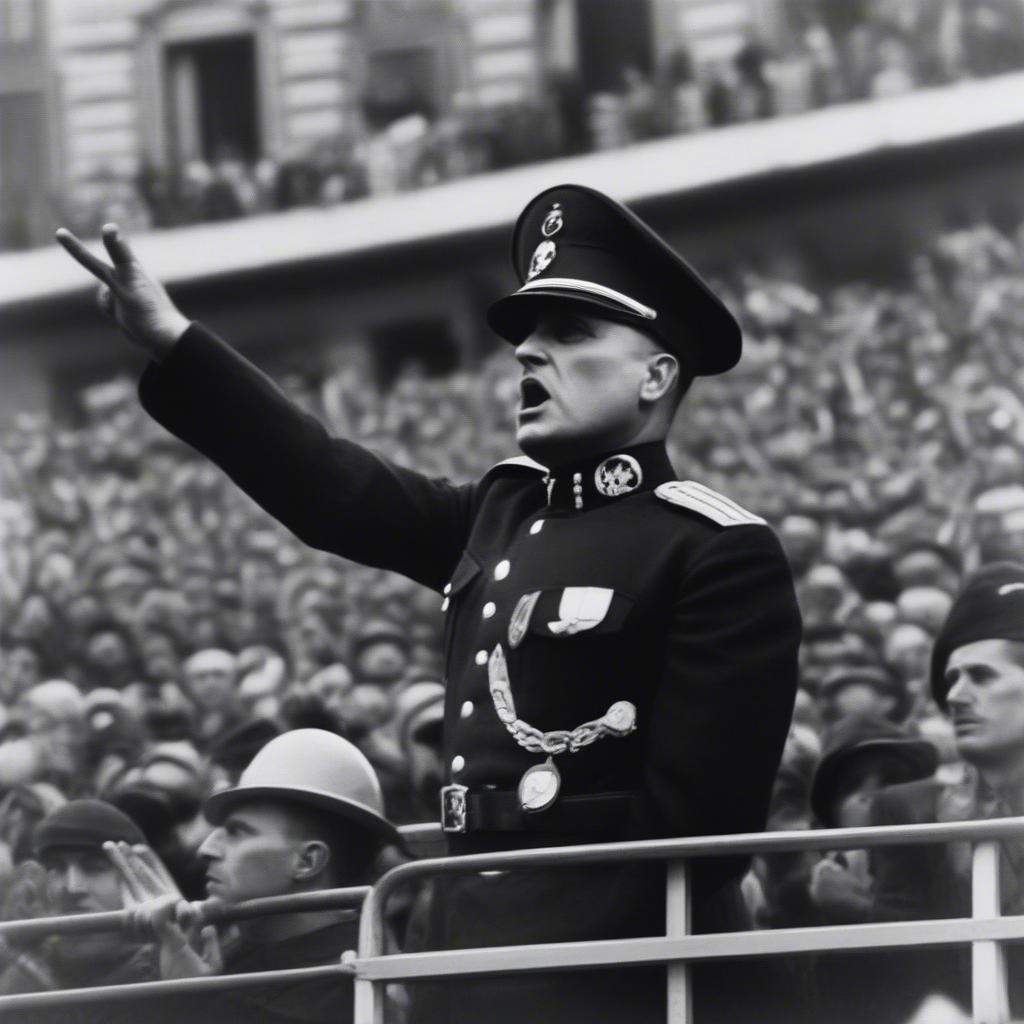
Benito Mussolini, often referred to as “Il Duce” (The Leader), was a pivotal figure in the 20th century, notorious for his role as the founder of Italian Fascism and as a key player in World War II. Understanding who Benito Mussolini was requires delving into his complex life, examining his ideological foundations, his rise to power, his brutal regime, and ultimately, his downfall.
Table Content:
From Socialist Roots to Fascist Dictator
Mussolini’s early political leanings were surprisingly far from the far-right ideology he would later champion. He started his political career as a socialist journalist and activist, even being expelled from Switzerland for his revolutionary views. However, his fervent nationalism and disillusionment with socialist pacifism during World War I led him to embrace a new ideology: Fascism.
This nascent political movement, born from the chaos and disillusionment of post-war Italy, promised order, national revival, and a rejection of both liberal democracy and communism. Mussolini’s charismatic leadership and powerful rhetoric resonated with a nation yearning for stability and strength. He skillfully tapped into widespread discontent with the existing political order, promising a return to Roman glory and a revitalized Italian empire.
The March on Rome and the Consolidation of Power
In 1922, Mussolini orchestrated the “March on Rome,” a dramatic display of Fascist strength that intimidated the Italian government into handing him the premiership. Although initially operating within a parliamentary framework, Mussolini quickly moved to consolidate his power, suppressing opposition parties, curtailing civil liberties, and establishing a one-party state.
He implemented strict censorship, controlled the media, and created a vast propaganda machine to cultivate a cult of personality around himself. Dissenting voices were silenced through violence and intimidation by the Blackshirts, Mussolini’s paramilitary force. The Fascist regime permeated every aspect of Italian life, from education and youth organizations to labor unions and cultural institutions.
Mussolini’s Italy: A Totalitarian State
Under Mussolini’s rule, Italy was transformed into a totalitarian state, where the Fascist Party exercised absolute control. The economy was heavily regulated, with the state playing a dominant role in industry and agriculture. Individual freedoms were sacrificed for the perceived good of the nation, and dissent was brutally suppressed.
Mussolini’s foreign policy was characterized by aggressive expansionism, aiming to recreate the Roman Empire. He invaded Ethiopia in 1935, a brutal campaign that exposed the brutality of the Fascist regime to international condemnation. This act of aggression further isolated Italy on the world stage.
 Benito Mussolini addressing a large crowd in Rome
Benito Mussolini addressing a large crowd in Rome
The Alliance with Hitler and World War II
Mussolini initially viewed Hitler with suspicion, but the shared ideology of Fascism and the promise of territorial gains drew the two dictators closer. In 1936, they formed the Rome-Berlin Axis, a pact that would have devastating consequences for the world. Italy’s entry into World War II alongside Nazi Germany in 1940 proved to be a disastrous miscalculation.
The Italian military was ill-prepared for a major conflict, and a series of defeats in North Africa and Greece exposed the weakness of Mussolini’s regime. As the war turned against the Axis powers, Mussolini’s popularity plummeted, and he was overthrown and imprisoned in 1943.
The Final Act: Death and Legacy
Rescued by German forces, Mussolini was installed as the head of a puppet state in northern Italy. However, his reign was short-lived. As the Allied forces closed in, he attempted to flee to Switzerland but was captured and executed by Italian partisans in April 1945. His body, along with that of his mistress, Clara Petacci, was hung upside down in a Milan square, a gruesome end that symbolized the ignominious collapse of his regime.
Benito Mussolini’s legacy is one of tyranny, aggression, and ultimately, failure. He left Italy devastated by war and discredited on the world stage. His regime serves as a stark reminder of the dangers of totalitarian ideologies and the importance of safeguarding democratic values. He remains a figure of historical significance, reminding us of the fragility of freedom and the devastating consequences of unchecked power. His story continues to be studied and debated, serving as a cautionary tale about the seductive allure of authoritarianism and the importance of vigilance in defending democratic principles. who fought in ww2 provides further context on the global conflict in which Mussolini played a significant role.
 Mussolini and Hitler meeting, representing the Axis powers alliance.
Mussolini and Hitler meeting, representing the Axis powers alliance.
FAQ
What is Benito Mussolini most known for? Benito Mussolini is best known for founding Fascism in Italy and leading the country into World War II as an ally of Nazi Germany.
What was Fascism? Fascism was a political ideology characterized by authoritarianism, nationalism, militarism, and the suppression of individual liberties.
How did Mussolini rise to power? Mussolini rose to power through a combination of political maneuvering, violence, and propaganda, culminating in the March on Rome in 1922.
What was the outcome of Mussolini’s rule? Mussolini’s rule led to Italy’s involvement in a disastrous war, economic hardship, and the suppression of basic human rights. He was ultimately overthrown and executed.
What is the significance of “Il Duce”? “Il Duce,” meaning “The Leader,” was the title Mussolini adopted, reflecting the cult of personality he cultivated around himself.
How did World War II impact Mussolini’s regime? Italy’s military failures in World War II exposed the weakness of Mussolini’s regime and led to his downfall.
What lessons can be learned from Mussolini’s rise and fall? Mussolini’s story serves as a warning against the dangers of authoritarianism, the importance of democratic values, and the need for vigilance in protecting freedom.